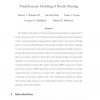Free Online Productivity Tools
i2Speak
i2Symbol
i2OCR
iTex2Img
iWeb2Print
iWeb2Shot
i2Type
iPdf2Split
iPdf2Merge
i2Bopomofo
i2Arabic
i2Style
i2Image
i2PDF
iLatex2Rtf
Sci2ools
101
click to vote
ISER
2004
Springer
2004
Springer
Nonholonomic Modeling of Needle Steering
As a flexible needle with a bevel tip is pushed through soft tissue, the asymmetry of the tip causes the needle to bend. We propose that, by using nonholonomic kinematics, control, and path planning, an appropriately designed needle can be steered through tissue to reach a specified 3D target. Such steering capability could enhance targeting accuracy and may improve outcomes for percutaneous therapies, facilitate research on therapy effectiveness, and eventually enable new minimally invasive techniques. In this paper, we consider a first step toward active needle steering: design and experimental validation of a nonholonomic model for steering flexible needles with bevel tips. The model generalizes the standard three degree-of-freedom (DOF) nonholonomic unicycle and bicycle models to 6 DOF using Lie group theory. Model parameters are fit using experimental data, acquired via a robotic device designed for the specific purpose of inserting and steering a flexible needle. The exp...
Bevel Tips | ISER 2004 | Needle Steering | Robotics | flexible Needle |
Related Content
| Added | 02 Jul 2010 |
| Updated | 02 Jul 2010 |
| Type | Conference |
| Year | 2004 |
| Where | ISER |
| Authors | Robert J. Webster III, Noah J. Cowan, Gregory S. Chirikjian, Allison M. Okamura |
Comments (0)

